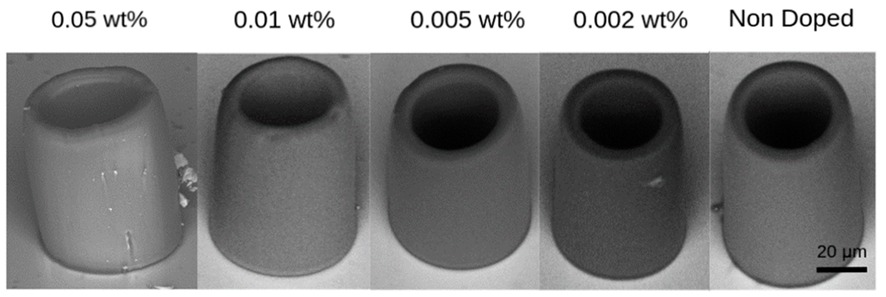

Cylindrical microstructures formed by a photoresist doped with different proportions of nanodiamond are shown in these scanning electron microscope images (credit: researchers’ archive)
Researchers at the University of São Paulo’s São Carlos Institute of Physics developed the technique, which can be used in information processing and cell marking, among many other applications.
Researchers at the University of São Paulo’s São Carlos Institute of Physics developed the technique, which can be used in information processing and cell marking, among many other applications.

Cylindrical microstructures formed by a photoresist doped with different proportions of nanodiamond are shown in these scanning electron microscope images (credit: researchers’ archive)
By José Tadeu Arantes | Agência FAPESP – A nitrogen-vacancy (NV) center is a defect in the crystal structure of diamond, where a nitrogen atom replaces a carbon atom in the diamond lattice and a neighboring site in the lattice is vacant. This and other fluorescent defects in diamond, known as color centers, have attracted researchers’ attention owing to their quantum properties, such as single-photon emission at room temperature and with long coherence time. Their many applications include quantum information encoding and processing, and cell marking in biological studies.
Microfabrication in diamond is technically difficult, and nanodiamonds with color centers have been embedded in custom-designed structures as a way of integrating these quantum emitters into photonic devices. A study conducted at the University of São Paulo’s São Carlos Institute of Physics (IFSC-USP) in Brazil established a method for this, as described in an article published in the journal Nanomaterials.
“We demonstrated a method of embedding fluorescent nanodiamonds in microstructures designed for this purpose, using two-photon polymerization [2PP],” Cleber Mendonça, a professor at IFSC-USP and last author of the article, told Agência FAPESP.
“We studied the ideal concentration of nanodiamond in the photoresist to achieve structures with at least one fluorescent NV center and good structural and optical quality.” The photoresist is a light-sensitive material used in the fabrication process to transfer nanoscale patterns to the substrate.
Mendonça and his group have made extensive use of 2PP to fabricate three-dimensional microstructures. Simply put, 2PP is a direct laser writing technique in which a high-intensity laser beam is focused on a light-sensitive polymer resin that has not yet solidified to produce the microstructure of interest.
In the study, a nanodiamond solution in deionized water was added to the mixture of monomers that comprised the photoresist, and after all the requisite physicochemical procedures had been completed, microfabrication was performed by submitting the sample to pulses from a powerful titanium-sapphire laser controlled by dedicated software to define the exact coordinates of the beam.
“Fluorescence and Raman spectroscopy measurements were used to confirm the presence and location of the nanodiamonds, while absorbance measurements assessed scattering losses at higher concentrations. Our results show the feasibility of fabricating microstructures embedded within fluorescent nanodiamonds via 2PP for photonics and quantum technology applications,” the authors write in the article.
The study was part of the PhD research of first author Filipe Assis Couto, with Mendonça as thesis advisor. It was supported by FAPESP via five projects (09/54035-4, 13/07276-1, 18/11283-7, 19/27471-0, and 20/08715-2).
The article “Integrating fluorescent nanodiamonds into polymeric microstructures fabricated by two-photon polymerization” is at: www.mdpi.com/2079-4991/13/18/2571.
Republish
The Agency FAPESP licenses news via Creative Commons (CC-BY-NC-ND) so that they can be republished free of charge and in a simple way by other digital or printed vehicles. Agência FAPESP must be credited as the source of the content being republished and the name of the reporter (if any) must be attributed. Using the HMTL button below allows compliance with these rules, detailed in Digital Republishing Policy FAPESP.





